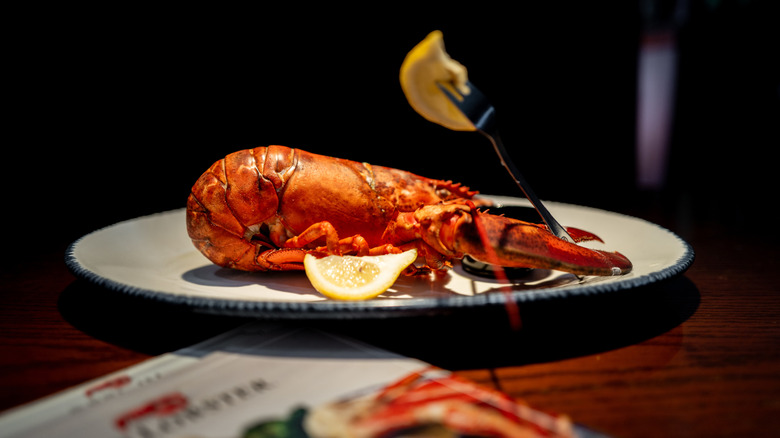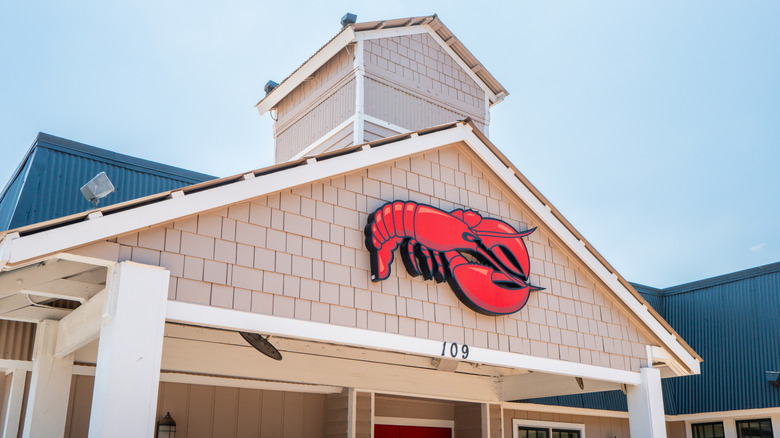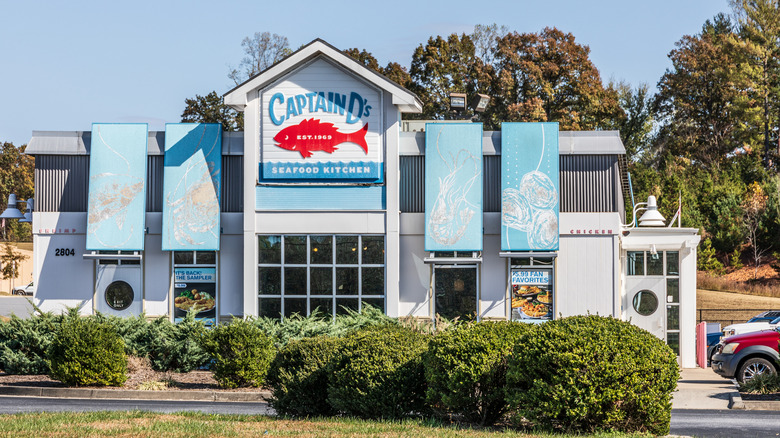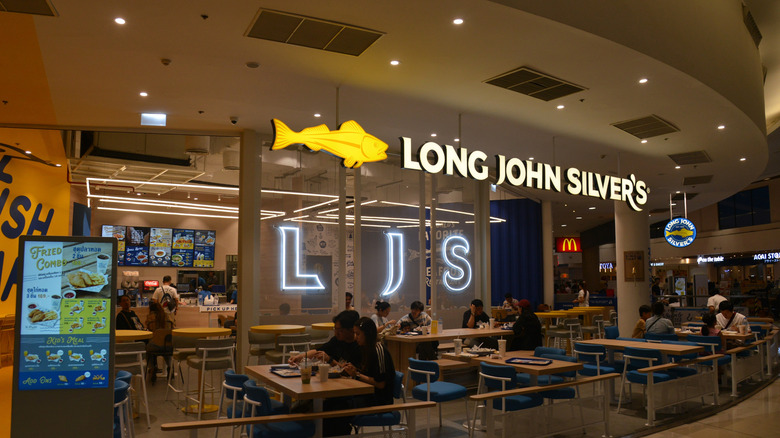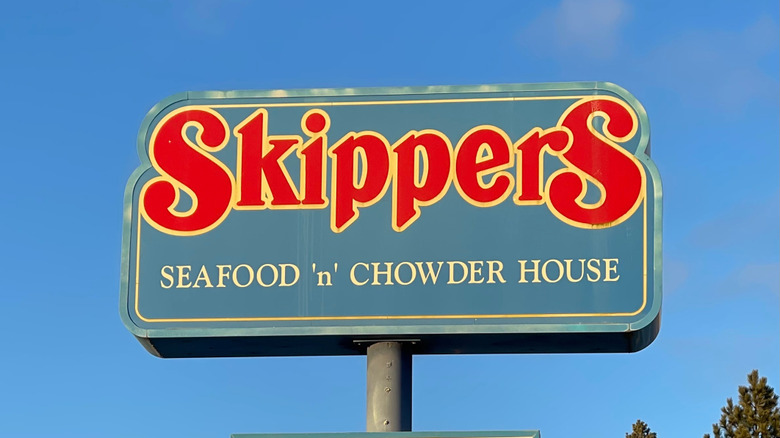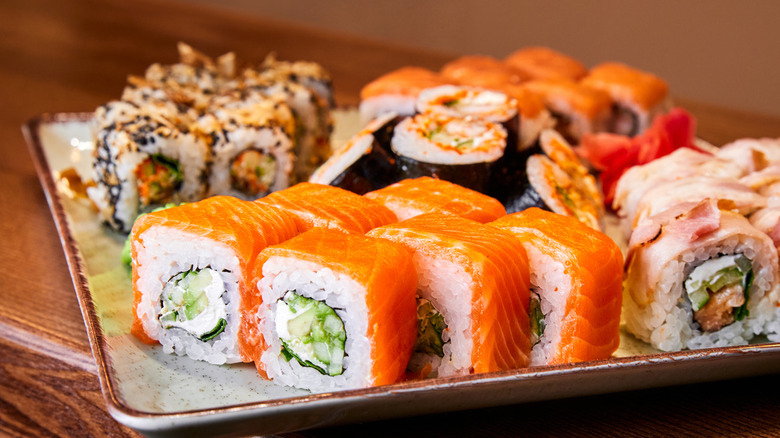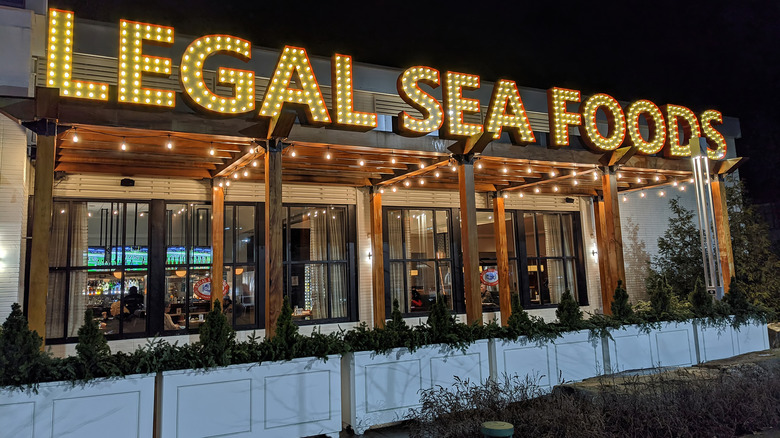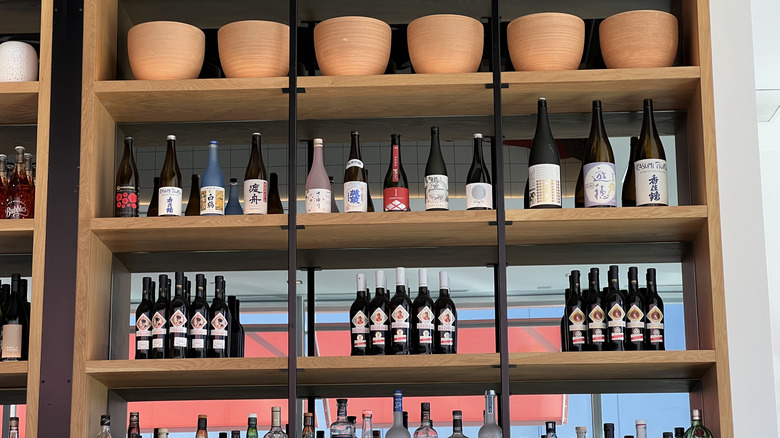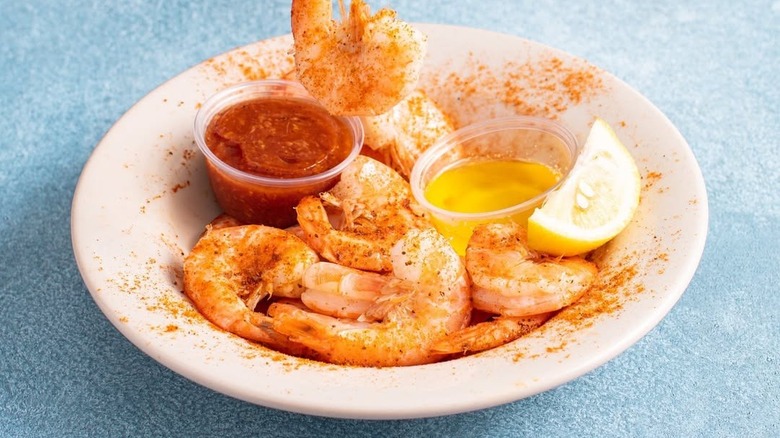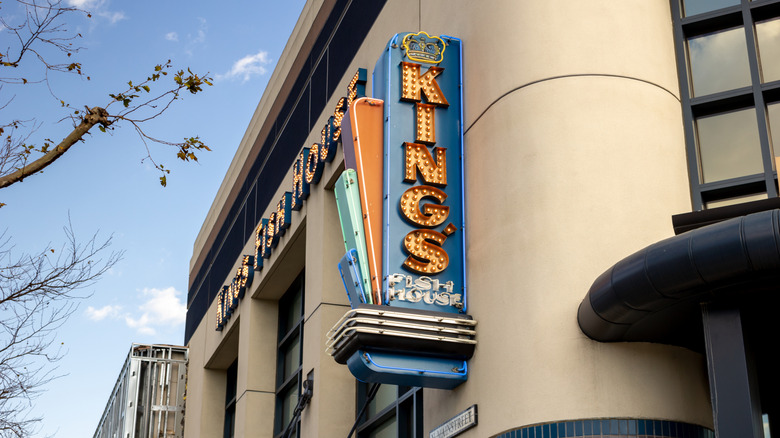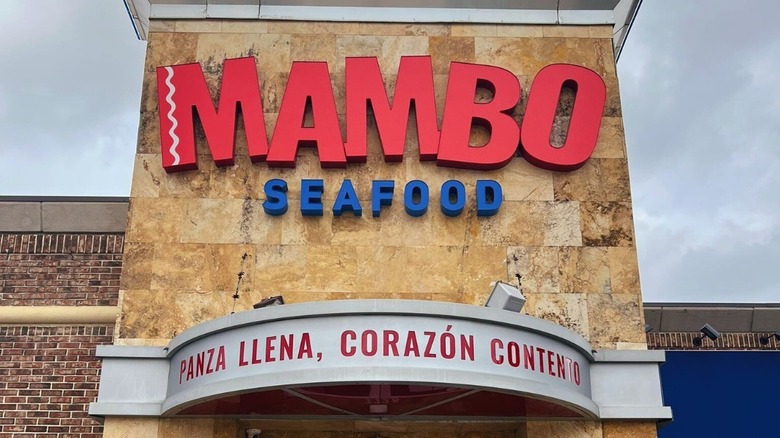11 Once Beloved Seafood Chains That Are Making A Resurgence
Seafood chains — and really, many restaurant chains — have had a tough go of it for a while. Whether owing to supply chain challenges, changing consumer dynamics, or the ravages of the COVID-19 pandemic, seafood fans have seen multiple beloved chain locations shutter across the country. Even Red Lobster, once considered the biggest seafood chain in the world with more than 700 locations and a customer base of over 60 million, found itself shuttering dozens of locations across the United States at the tail end of May 2024 after years of mismanagement left it knee-deep in debt and dangerously low on cash.
But it's not all bleak. Comebacks, though rare, aren't entirely unheard of. The biggest comeback of 2025 appears to be Red Lobster, whose stint in financial peril lasted less than a year — but even chains you'd perhaps considered long dead and buried (like, say, Arthur Treacher's Fish & Chips), can still come back from the brink. To illustrate, here's a rundown of some popular seafood chains that, while not yet returned to their former glory, have managed to dust off the ashes of near-collapse.
Red Lobster
Known for its sought-after Cheddar Bay Biscuits, Red Lobster has grown exponentially since opening its first location in Lakeland, Florida in January 1968. Things started going downhill in 2014 after the chain was acquired by Golden Gate Capital. The San Francisco-based private equity firm quickly entered a sale/leaseback deal that left the chain hobbled with debt from paying rent on real estate it had previously owned.
The hits just kept coming from there. Competition from fast-casual chains, supply chain challenges, COVID-19, and years of mismanagement under Thai Union Group (an equity partner of Golden Gate Capital) left the chain barely scraping by. The $20 all-you-can-eat shrimp deal, which the chain gradually raised prices on, was the final blow — draining $11 million from its heavily hobbled 2023 returns. By the time it filed for bankruptcy in May 2024, Red Lobster had just under $30 million in cash and a startling $1 billion in debt — not to mention that its unit portfolio had shrunk from over 700 in 2014 to just under 600.
Fortunately, the chain didn't have to languish in the mire of Chapter 11 restructuring for long, as it was — just four months after the headline-blaring filing —acquired by RL Investor Holdings, albeit for a fraction of its value. Aside from streamlining the chain's bloated unit portfolio, which was slashed down from the 578 disclosed in the bankruptcy filing to 538, the new owner committed to investing more than $60 million in revitalizing the struggling chain. Customers were already starting to reap the benefits of the brand's resurgence as early as November 2024 with the return of popular menu items like hush puppies, bacon-wrapped scallops, and cornmeal fritters.
Captain D's Seafood Kitchen
Captain D's — a legacy fast-casual seafood chain whose food actually lives up to the hype, especially that giant fish sandwich (arguably one of the best fast food fish sandwiches out there, packed with just as much fish as you'd expect in a sandwich that calls itself giant). Sadly, like many other seafood chains, Captain D's found itself on the outs with diners across the country back in the 2010s, leading to a significant drop in revenue. In 2011 alone, the chain's then 519 locations generated sales of $433 million, down from $436 million the previous year. Multiple locations shuttered before then-owner Sagittarius Brands sold the chain off to Florida-based private equity firm Sun Capital Partners, which eventually offloaded it over to its affiliate Centre Partners Management in 2013.
The chain has since undergone significant revitalization, introducing all-new kitchen designs, double drive-thrus, and a menu overhaul to increase consumer appeal. With a price tag of at least $111,000 per unit, the strategic remodeling spurred a major resurgence, with per unit volume growing from $832,000 in 2011 to a whopping $1.4 million in 2017. The brand has also seen a major uptick in franchising, adding close to a dozen more units to its portfolio since 2011, with plans for local and international expansion to bring its unit portfolio to an impressive 1,000.
Long John Silver's
There was a time when Long John Silver was the undisputed overlord of the quick service seafood market, with a market share of a startling 66% and a unit portfolio reaching an all-time high of 1,500 locations in 1989. The chain's grip on the market has since eased significantly, spurred not just by a revolving door of acquisitions but also increased competition from larger fast-casual dining chains, changing consumer habits, and supply chain irregularities.
The chain's unit portfolio had dropped to 740 by 2019, declining by a further 6% in 2020, and reaching an all-time low of 670 in 2021. Things were no less grim on the revenue front. Despite seeing slight growth in same-store revenue at the start of 2019, the chain was — like many in the seafood game — ravaged so severely by the pandemic that year-over-year sales dropped by a startling 17% in 2020.
Long John Silver's began course-correcting in 2019, starting off with streamlining its workforce to reduce labor costs, cutting back on advertising, and reorganizing inventory to slash working capital. Cost-cutting freed up revenue significantly, allowing the chain to invest in remodeling its existing units, third-party delivery, and technology to enhance drive-thru efficiency. The changes spurred a major resurgence, with year-over-year system-wide sales growing an impressive 2.5% in both 2021 and 2022. Franchising momentum also saw a significant uptick, especially in Asia, with plans underway for 54 more locations in Indonesia and 21 in Singapore.
Skippers Seafood & Chowder House
When you think of the absolute best places to get fish n' chips, Skippers Seafood & Chowder House rarely comes to mind — unless, of course, you're nostalgic for the '80s. But while no one's exactly lining up these days for Skippers' signature Northwestern-style fish n' chips, there was a time when the chain boasted a portfolio of over 200 locations, easily ranking among the largest seafood chains countrywide.
Skippers' descent into obscurity began in the early '90s when it was acquired by National Pizza Company, which swapped out Skippers' time-tested tradition of prepping their fish fresh in-house for a straight-from-the-freezer-to-the-fryer approach — cheaper, sure, but also a really terrible way to make fried fish. The years that followed were rough. The chain hemorrhaged locations, losing nearly two-thirds of its units before filing for bankruptcy in 2006 and ultimately liquidating in 2007. By 2020, just six Skippers locations remained in the entire country.
The brand got a second wind shortly after liquidation, when its intellectual property was sold off to Starway Restaurants LLC. Teaming up with Harbor Wholesale, Starway launched a wave of smaller, grab-and-go "Skippers Go Fleet" locations across the country. By 2022, there were more than 120 of these mini Skippers nestled inside select retail outlets, mainly in Washington, Idaho, Oregon, and California. Starway eventually sold the brand to Harbor Wholesale outright, which now plans to push beyond the "Go Fleet" model and put Skippers back on the map — not just in the Northwest, but anywhere people are craving old-school fish n' chips done right.
Sushi Zushi
Sushi has gained significant traction among American diners over the past couple of decades, and one brand that really rode the wave — at least until recently — is Austin-based Sushi Zushi. Known for its Tex-Mex inspired signature rolls, the chain saw rapid growth after opening its first brick-and-mortar location in Texas in 2011, expanding to over seven locations in under a decade. However, just seven years in, the chain found itself encumbered by significant debt. Founder Alfonso Tomita brought in partners TXFMP Management LLC to revive the brand, with hopes of increasing its footprint across the country. Unfortunately, just as that partnership took shape, COVID hit, and the brand found itself floundering once again.
By 2024, the chain was knee-deep in debt — $3.9 million of it, to be exact — and had very little cash on hand, a little over $700,000. Its unit portfolio had also shrunk to just three locations, former distributors and landlords were suing left and right, and an internal wrangle had broken out between Tomita and TXFMP Management LLC principal Jason Kemp. In June 2024, the chain finally bit the big one and filed for Chapter 11 bankruptcy.
Fortunately, Sushi Zushi's exit from bankruptcy protection doesn't appear quite so bleak, as it's since partnered with Atlanta-based ghost kitchen pioneer Franklin Junction to give the chain's signature menu items a new lease on life. Franklin Junction also hopes to leverage Sushi Zushi's now-idle kitchens to service its other partner brands ... a move that, according to the San Antonio Express-News, could generate a 50% profit margin for Sushi Zushi.
Arthur Treacher's Fish & Chips
Founded in 1969, Arthur Treacher's Fish & Chips enjoyed rapid growth in the 1970s, attaining a nationwide footprint of more than 800 units in under a decade. Customers loved the chain's preference for cod in their fish n' chips (hands down one of the best fish for frying), and with very minimal competition in the seafood game at the time, it became increasingly popular among crowds with reservations against other types of meat — like say, Catholics during Lent.
However, by the mid-1970s, confrontations between Iceland and the United Kingdom over North Atlantic fishing rights had reached a fever pitch, with the former expanding its exclusive zone to 200 miles. With cod prices skyrocketing as a result, Arthur Treacher's tried to swap it out for pollock, which alienated diners and began a decades-long downward spiral for the brand.
By the time the 1980s rolled around, Arthur Treacher's had bled out most of its locations and was deep in the throes of Chapter 11 bankruptcy. By 2021, only two units remained afloat from the wreck, and the brand had almost completely retreated to obscurity. The chain got a helping hand on its way to the bottom in 2021 from Nathan's Famous, which planned to relaunch the brand as a ghost kitchen concept — and yes, bring back that sought after cod. Arthur Treacher's seems to have rediscovered its sea legs since then, as was evident from the revival of its Ohio location in Cleveland Heights in April 2025.
Legal Seafoods
Boston-based seafood chain Legal Sea Foods has built an admirable legacy since opening its first restaurant in Inman Square in 1968 — including the very rare honor of having its signature New England clam chowder (made with just about every ingredient that can zest up a clam chowder) served at presidential inaugurations year after year since the early '80s.
However, just like almost every player in the seafood game, the chain floundered hard during the COVID-19 pandemic. Its urban locations were hit the hardest, with sales plunging nearly 75% almost overnight, while suburban spots saw a quieter — but no less brutal — 40% decline. By the time pandemic restrictions were rolled back, Legal Sea Foods had bled out nearly half its unit portfolio, and the remaining locations were struggling to stay afloat under mounting debt.
Thankfully, post-COVID years renewed hope of Legal Sea Food's survival, especially after its December 2020 acquisition by Medford-based restaurant group PPX Hospitality Brands. The new owners were keen on revitalizing the chain, starting off by revamping its hobbled supply chain and overhauling its menu to enhance customer appeal. PPX's revitalization efforts have given the chain the much-needed wherewithal to claw its way back. Multiple shuttered units have reopened, and two new ones — one at Boston's Logan Airport and another in Virginia Beach — have been added to its portfolio.
Bamboo Sushi
Consumers are becoming increasingly conscious about seafood sustainability, but very few in the seafood game have truly caught up. Case in point: Blue fin tuna still remains extremely popular in Japanese cuisine, despite rapidly waning numbers. A standout exception is Sustainable Restaurant Holdings, owner of the world's first-ever sustainable sushi chain: Bamboo Sushi. With its first-ever spot in Portland opening its doors in 2008 and boasting among other things a pretty stacked nigiri lineup (20 options to be exact!), and a downright flashy selection of specialty rolls, Bamboo Sushi seemed poised to take over the sushi game; all without adding onto the bluefin tuna crisis, a rare and pretty laudable accomplishment.
For a time, that's exactly the route things were taking, with seven more locations springing up around the country, and two more units slated to open in San Francisco's Bay Area as of 2019. But then, COVID struck. With dine-in suspended and revenues plummeting, Sustainable Restaurant Holdings found itself struggling to stay afloat, ultimately filing for bankruptcy in May 2020. Bamboo Sushi locations shuttered across the country — until the brand was snapped up from Chapter 11 by private equity firm Sortis Holdings that July. Bamboo has since made a quiet, but no less notable comeback in the seafood game, reopening all its shuttered locations, and launching its second Denver location in January 2025.
Shells Seafood
Founded in 1985, Shells Seafood expanded rapidly in the late 1980s and 1990s, reaching a nationwide footprint of 50 units by the close of the 20th century. Customers loved the chain's no-frills approach to casual dining, and the fact that at Shells Seafood, you could get a lot more than your classic fish n' chips — like say, lobster tails tossed in lobster cream sauce served over linguine — all at dockside prices.
The downturn began when the chain went public in the '90s and ended up saddled with a corporate board that preferred rapid expansion over maintaining quality. Shells soon found itself with a bloated unit portfolio that had almost no prayer of surviving any real economic uncertainty. When the recession hit in the mid-2000s, Shells Seafood had already bled out more than half its units and was struggling to squeeze profit from what remained, only turning a profit in one year between 1999 and 2008. Efforts to revitalize the brand — like a menu overhaul and launching a high-end iteration called Rock Beach Grill — came too late to stop the bleeding.
In September 2008, Shells' executives finally called time and began efforts to restructure under Chapter 11. However, a move to secure capital injection proved futile, and the brand was ultimately forced to liquidate just weeks later, shuttering its remaining 10 locations. More than a decade later, the chain is clawing its way from the murk, making its first comeback in 2012 with a location on Fowler Avenue in Tampa, Florida. In 2019, Shells opened a new location in Lakeland, Florida, bringing its portfolio to an impressive six.
King's Fish House
Casual dining seafood chain King's Fish House saw rapid growth after opening its first location on Pine Avenue in Long Beach, California, expanding to 11 units by 2007 — most of them clustered in Southern California. Unlike other fast-growing casual dining spots at the time, King's set itself apart with an ever-evolving menu and a rare regard for sustainability in sourcing its seafood. For instance, the chain scrapped endangered species like Orange Roughy from its menus as early as the 2000s.
This all meant that King's was able to weather the recession pretty well compared to other seafood chains of its ilk. It even clocked a 20% sales growth in 2006, a time when many seafood chains were shuttering locations left and right. But instead of riding that momentum into hyper-expansion, parent company King's Seafood hit pause on new-unit growth in 2007 and shifted focus to streamlining supply by opening its very own fish warehouse, King's Seafood Distribution Company.
With supply locked down, revitalization efforts for King's Fish House finally took center stage, beginning with a complete makeover of the existing 11 units — at the hefty price point of $2 million a piece. With remodels complete and supercharging revenue streams, King's Seafood was finally able to redirect its energies to expansion. And in October 2020, nearly two decades after it paused new-unit growth, King's Fish House added a 12th location to its portfolio; this time at the Westfield Valley Fair Mall in San Jose, California.
Mambo Seafood
Texas-based seafood chain Mambo Seafood has carved out a solid footprint since its first brick-and-mortar restaurant opened its doors in 1996. Popular among diners for its wide selection of Latin-inspired seafood dishes (sometimes with traces of Cajun, Argentinian, and even Chinese-Peruvian cuisine), the chain had grown to 11 units by 2022 — 10 under its own name and one franchised.
However, growth remained largely localized in the Houston area for quite some time, despite the brand's longstanding hopes of expanding across the greater Southwest. That all changed in 2022 when Mambo Seafood secured a capital injection from New York-based private equity firm Garnett Station Partners. Although the terms of the deal weren't made public, Garnett Station Partners manages assets worth well over $1 billion, so it's quite likely the chain received enough cash to expand beyond its Houston haunts ... and then some.
Since then, Mambo has made good on its plans to expand into the greater Southwest, growing from 11 to 16 locations across Texas in just two years. The San Antonio area seemingly received primal consideration, with three units springing up in quick succession between 2023 and 2024. Mambo's resurgence doesn't seem to be slowing down anytime soon. According to the Houston Chronicle, a 13th Houston location, this time in the Willowbrook area, opened its doors in May 2025.

